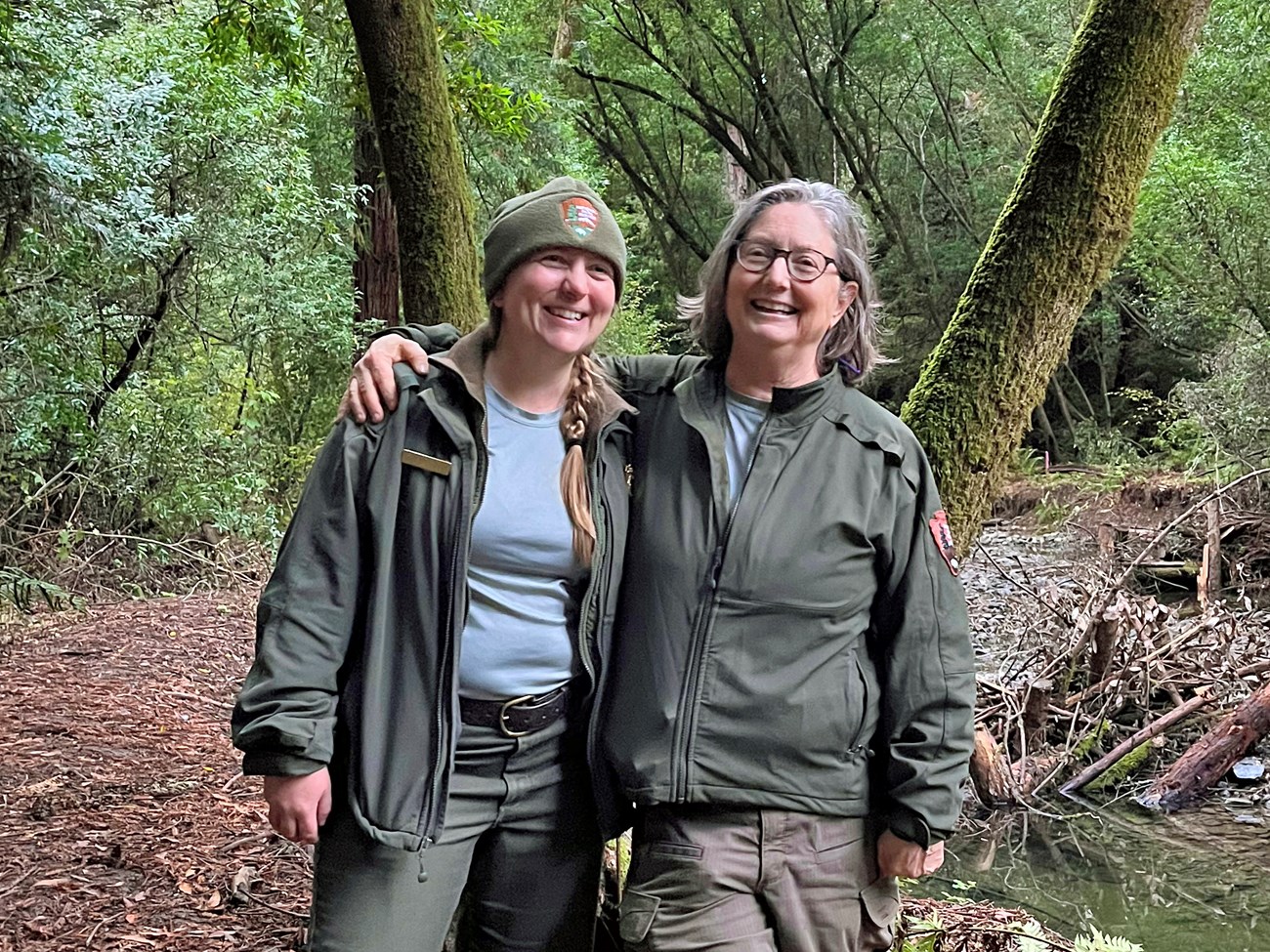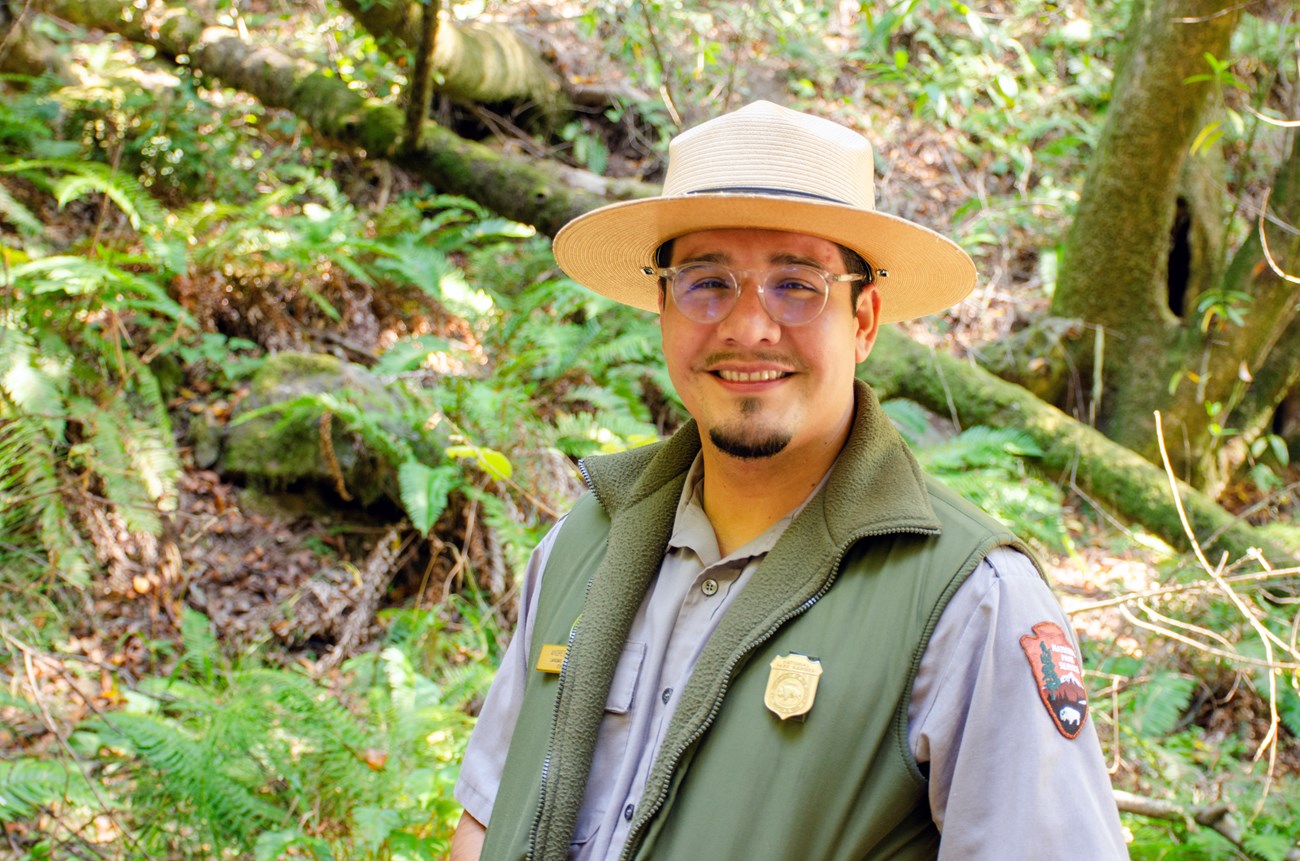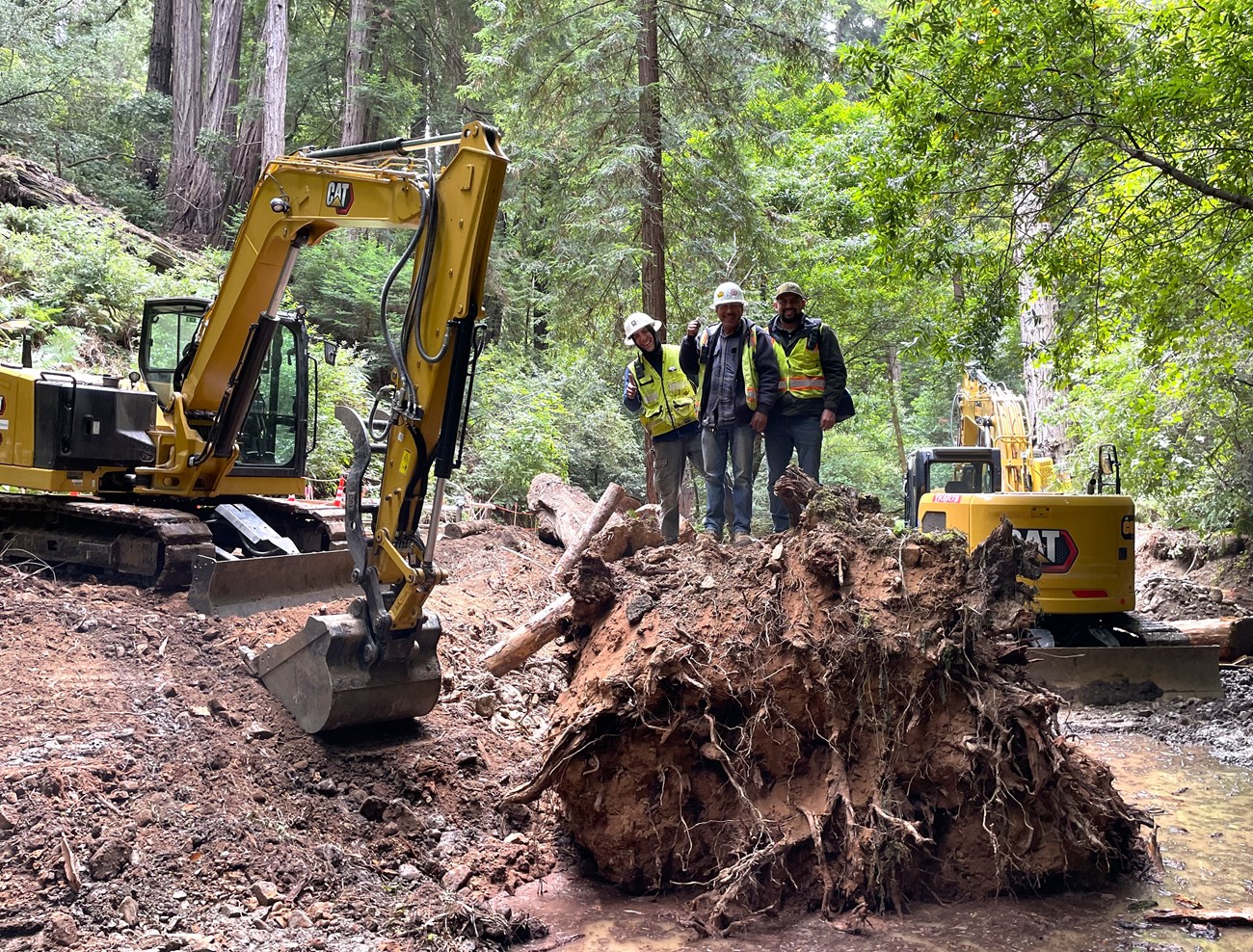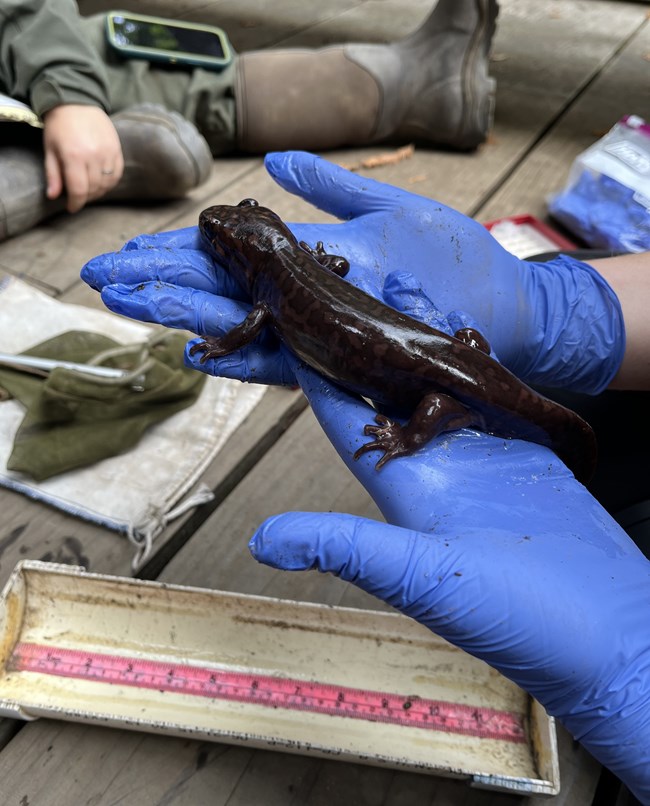Last updated: August 5, 2024
Article
“Our One Shot”: Restoring Redwood Creek, In Their Own Words
By Natural Resources Intern Maya Akkaraju, Golden Gate National Recreation Area
December 2023 - From July to November 2023, the usual serenity of Muir Woods National Monument was gone. In its place was a flurry of restoration activity. Beeping excavators, clanging rocks, and bustling crews’ voices filled the air as sections of the creek were restored to improve habitat for the endangered coho salmon who live here. This work marked the second and final phase of the Salmon Habitat Enhancement Project, after Phase 1 in 2019.

NPS / Avani Fachon
Staff from different corners of the National Park Service and a dedicated crew of contractors from Hanford Applied Restoration and Conservation (Hanford) worked together on the project. For them, these months were spent immersed in the creek beneath the park’s iconic redwoods. Read on for a look into the restoration zone from those who worked on-site.
Who's Who

NPS / Maya Akkaraju
Carolyn Shoulders
Project Manager, Golden Gate National Recreation Area
Carolyn Shoulders has managed the Salmon Habitat Enhancement Project since the outset. During restoration phases, she worked with site leaders, poring over design details—log placements, cobble volumes, rock removal—and solving the inevitable challenges that arise day to day when implementing even the most meticulously engineered plans.
Annie Berlinghieri
Lead Biomonitor, Golden Gate National Recreation Area
Annie Berlinghieri is a hydrologic technician with Golden Gate National Recreation Area. Part of her job is to collect and manage data about Redwood Creek before and after restoration to aid in project planning and evaluation. During the restoration phase, she also served as the Salmon Habitat Enhancement Project’s lead biomonitor. The biomonitors on site held the role of protecting the creek and its surrounding life, including any critters—salamanders, banana slugs, fishes—who found themselves in the restoration zones.

NPS / Avani Fachon
Frank Perez
Foreman, Hanford
Hanford Foreman Frank Perez worked on both phases of the Salmon Habitat Enhancement Project. His role involved coordinating closely with the National Park Service while leading his skilled crew of laborers, engineers, and equipment operators. The crew often managed several irons in the fire at a time. One excavator operator could be moving a fallen tree into the right position to create cover for future juvenile coho hiding away in a pool. Meanwhile, another could be slowly and gently pulling out giant boulders that were built into the creek banks in the 1930s. Removing these confining rock structures will give the creek room to meander and create slow-moving pools that juvenile salmon need to survive as they grow up in the creek.
Jeffrey Perez
Crew Leader, Hanford
Jeffrey Perez worked just beneath Foreman Frank Perez, his brother. He has worked at Hanford for seven years.

NPS / Avani Fachon
Andres Vasquez
Park Ranger, Muir Woods National Monument
Andres Vasquez worked on engaging visitors about the first phase of the Salmon Habitat Enhancement Project for the Golden Gate National Parks Conservancy in 2019. Now, after working in different parks, he is back at Muir Woods as a park ranger.
In Their Own Words
When did you start thinking about doing this project?
Shoulders:
“We first looked at it in 1999, knowing that it needed to be done. We learned then that because the riprap was considered a historic resource, but because it had not been through its formal processes yet, we wouldn’t be able to do anything out there for a long time. We came back to the project in 2015 after those initial processes had been done with the riprap.
“[Then] we were on the ground in 4 years for Phase 1.
“We’re really just inviting change, because [Redwood Creek] had been locked into one form for decades.
“It’s very intensive work on the [creek] channel. Your schedule is so constrained and it’s a lot to take large excavators up into Muir Woods, into a sensitive ecosystem.
“I felt a huge sense of responsibility along the way, partly because of the resource protection, and also because it does matter how you leave things and this is our one shot. We’re never going up there with equipment ever again.”

NPS / Annie Berlinghieri
How did you get into doing restoration work?
Jeffrey:
“The way I got here to Hanford doing ecological restoration was actually through my dad. He’s been here 40 years, and my brother [Frank] as well. I never really saw myself doing this kind of work, but after being exposed it almost became a passion.
“I’m in love with everything that the company does…We’ve done other sites at Point Reyes, San Mateo, but I would say Muir Woods out of all the jobs I’ve done is the most beautiful.”
Frank:
“My father first started with this company when he was 16. Hearing stories of him coming home every day saying that he changed rivers, or there were rivers where no water was flowing, and he made them flow by that winter, was something that inspired me to get into this kind of work.
“Other construction companies, they’ll build roads, they’ll build hospitals — the moment the construction company is finished with that project, that’s the best it’s ever going to look because every day after that, it’s starting to deteriorate.
“When we’re finished doing this project here, that’s the very first day it’ll ever look that good because every day after that, mother nature takes over and it becomes better and better throughout the years. I think my favorite part out of all this is coming back, bringing my children, and noticing — not noticing — that we did the work in the creek, making it look that natural. Nobody would ever imagine bringing equipment in these creeks.”
What was your experience like working at the restoration site every day?
Berlinghieri:
“It was variable and intense. I worked closely with our project manager, Carolyn Shoulders, and we worked long days on our feet with our brains engaged all the time. It seemed like there was always a new challenge to solve.
I had a range of duties including monitoring for and relocating salamanders and other animals, measuring water quality to ensure the construction activities had no negative impacts downstream, collecting survey data to support achieving design goals, and responding to unforeseen issues relating to the protection of the park’s natural resources.”

NPS / Jules Cooch
Frank:
“I’ve got guys here where it’s their first time doing creek work like this. They wouldn't have imagined in their lifetime that we’d be here building habitat for species that they didn’t even know that live here. They’re excited…It’s like putting your signature on this Earth that we’re doing something good for something more than us.”
Vasquez:
“Working with project managers and construction crews, and knowing that everything is changing every day, you can prep for one thing but tomorrow it’ll be completely different so you have to adapt to that super quick…In Phase 1 we had trail closures that were way more impactful, so we had tables out there so we could provide people with directions but also to ease the conflict. This time around, it feels a little more controlled.”
What were some challenges during the restoration?
Shoulders:
“We were working next to the plaza, which had been manipulated through time for other purposes, and as we worked there we kept finding new layers of other rock and features and contaminated soil we didn't expect. We had to turn around and backtrack and protect a bank we didn't plant to protect because the soils were so artificial.
“[At upstream work zones] you’re just reliant on whatever wood is lying around, you can’t import wood up there. It’s not a high enough density of wood for what we want to do…We’ll see how it develops over time.”

NPS / Avani Fachon
What was your favorite part of working on this project?

NPS / Maya Akkaraju
Berlinghieri:
“My favorite part of the construction phase was the many close interactions I had with the critters of the forest, especially the charismatic and elusive California giant salamander. I was surprised by the impressive number of critters we encountered during construction that we don't notice on a normal workday or a casual walk through the forest—they're so good at hiding and blending in.”
Jeffrey:
“This group that we have here is almost like a family now, because we all know each other really well. That’s one of the best things…all of us coming together as a community contributing to this project. Whether you’re the project manager, the operator, the laborer, we all contribute in our own way to be able to complete this whole project.”
Vasquez:
“The best thing about it from an interpretive viewpoint is being able to show people what conservation looks like. And it might not be something they’re expecting at all, because you have excavators and you have all these people in the creek—people wearing hard hats, people holding electric fishers. It’s been really fun to break down the history and what’s happening today, and what we’re hoping to happen in the future. It’s really cool to see that learning curve happen in real time.”
What is unique about your work?
Jeffrey:
“My job is basically to do all the surveying, to do all the mathematics, to get all the elevations for the meandering creek we’re doing here.”

NPS / Avani Fachon
“I like being on the ground, doing the labor part but also doing the survey. I like operating [heavy machinery] as well, but [on the ground] you get to communicate with the clients, the different workers, so you’re learning as you’re going.
“We’re doing good for the environment, but at the same time, people become more curious about what we’re doing. That’s one of the best things about doing this job, being able to communicate with a lot of people but also being able to educate the public on something they might not know yet.”
What was it like working with different project partners every day?

NPS / Avani Fachon
Shoulders:
“Between interp [rangers] and the Visitor Center, everybody participated in still making Muir Woods a good visitor experience despite all the noise and the construction…What interp was doing was helping visitors see that we’re actually managing an ecosystem and not just a grove of trees. There’s huge value in that.
“I admire [the Hanford crew’s] skills so much. The ability to work with your hands and your body is an underrated skill, to do it every day all day like that.
“To have an excavator operator who has so much finesse, and is so careful, and always in good humor, and always has a new trick up his sleeve to do something difficult, that was just primo.”
Vasquez:
“The first time I ever worked with Carolyn in 2019, that’s when I was like ‘Oh wow, this person is a whole different type of person than I’ve ever met, because they’re super focused on the project, they’re really relying on me for this project that plays into a bigger picture.’ Seeing her determination and focus really introduced me to the amount of care that the [National] Park Service puts into the work.
“The Hanford guys are really cool. I like that if they have time they’ll tell you what they’re doing. They remembered me, they were like ‘You look older! You have facial hair now!’”
What’s it like to work in a publicly visible area?
Frank:
“I think we’re used to it. For [heavy machinery operator] Tony, it’s almost like his backyard when he’s pulling that bay tree and there are people taking pictures. Sometimes it looks pretty sketchy when he’s only on the tips of his tracks, but he knows that machine like it’s his body.
“It’s exciting for us to have people see this kind of work and appreciate what we’re doing. I’ve had a lot of people say ‘Thank you for the hard work.’ That’s a good feeling. It keeps morale really high.”
How does it feel to have finished both phases of the salmon habitat enhancement?
Shoulders:
“Fantastic. We actually did it. A lot of people contributed a lot of work and skills to it, and we actually got somewhere with it. We’ve changed the trajectory at this point, into the future, whatever that may be.
“It was on a daily basis really demanding and exhausting but it was also interesting and kind of thrilling and it was worth it.”

NPS / Avani Fachon
What are you taking away from this experience?
Berlinghieri:
“A deeper appreciation for redwood forest ecosystems. Being in the woods and the creek day after day, sometimes at odd hours, I experienced the woods and the wildlife in a different and deeper way.
I'm very grateful to be working with an amazing team of people who are passionate and thoughtful about taking good care of the forest and the creek and their inhabitants.”
On the future of environmental restoration
Jeffrey:
“It’s important for the youth to start learning about this, because later on we’re going to need more workers in this type of field…I’m active in school right now for the work I do—environmental studies. Hopefully in the future there are more people wanting to do this type of work because it is important.”
